Monday Must Reads: Volume 29
This blog post contains Amazon affiliate links. As an Amazon Associate, I earn a small commission from qualifying purchases.
Happy Monday! It’s time again for a new volume of Monday Must Reads. I’m extra thankful for having a relaxing weekend with no workshop presentations to give! Speaking of workshop presentations, I need to start trying to turn my presentation into a series of blog posts.

Here are the “must-read” ideas I ran across this week on twitter and in my RSS feed!
Median = Mean = Mode = Range
Team Maths shares a great new task from the great Don Steward. If you haven’t checked out Don’s blog, you need to stop everything and check it out right now! Now, we just need to convince Don to join us on twitter…

Radicals and Area Puzzle
Working on radicals with your students? Check out this great problem that Hannah found and shared on twitter! To the best of my knowledge, the problem was originally created by Jason Steele.
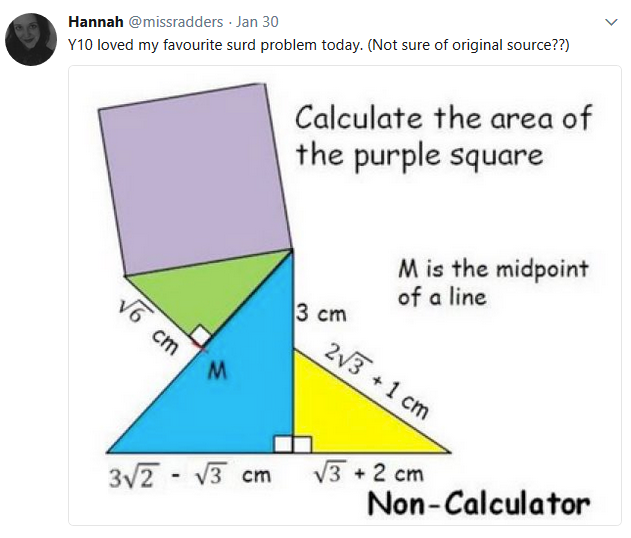
Circle Radius Puzzle
Chris Smith has featured a great geometry puzzle in his weekly newsletter. If you haven’t signed up for this bit of brilliance that arrives in your inbox once a week, you need to do so now! You can sign up for free by sending Chris an email at aap03102(at)gmail(dot)com.
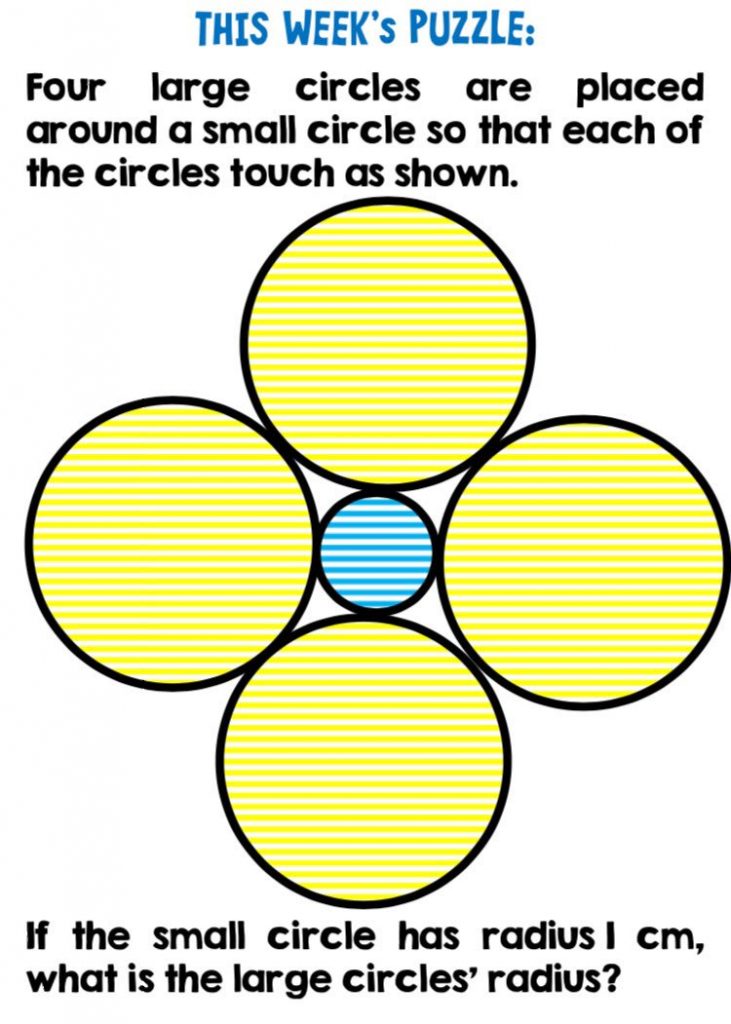
February Math Fact-orial
Need further proof that Chris Smith is amazing? Check out this awesome fact about February!

Matching Expressions and Visuals
David Wees shares a great image to spark conversations about connecting representations in math. I see so much potential for using this in my classroom!

Linear vs Exponential vs Quadratic Task
Here’s another great task from David Wees.

Exponent Rules True and False Activity
Exponent rules are such a tricky thing to teach. I especially like this approach from Kristin McNair where students are given answers and have to determine if they are true or false.
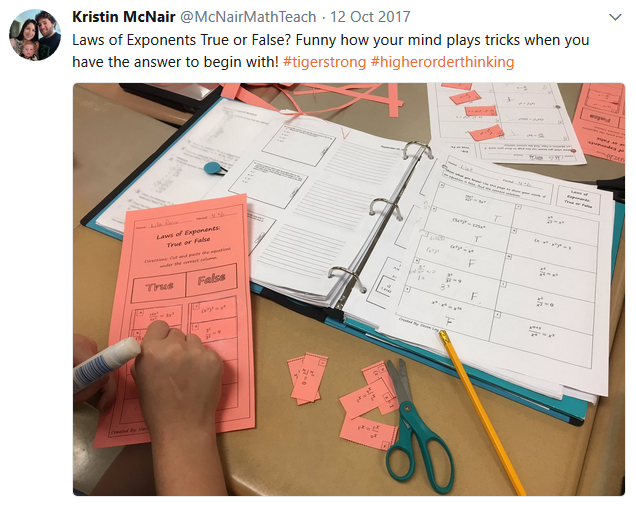
Geometric Probability with Nerf Guns
Geometric probability has never been my favorite topic to teach, but Mrs. Palker‘s approach to this topic with nerf guns makes it sound like a fun topic to teach!
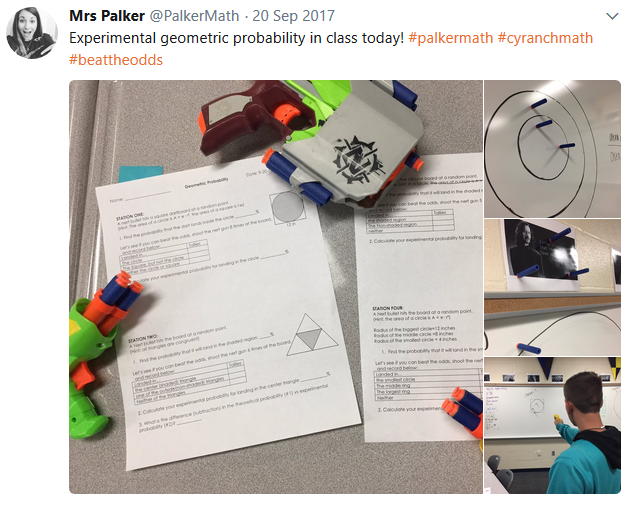
Like Terms Card Sort
Mrs. Helms shares a great idea for practicing identifying like terms: a card sort. I’ve played games before to practice this, but I think my students would benefit from doing a card sort BEFORE playing the game. I could even use the same cards for the sort and the game!
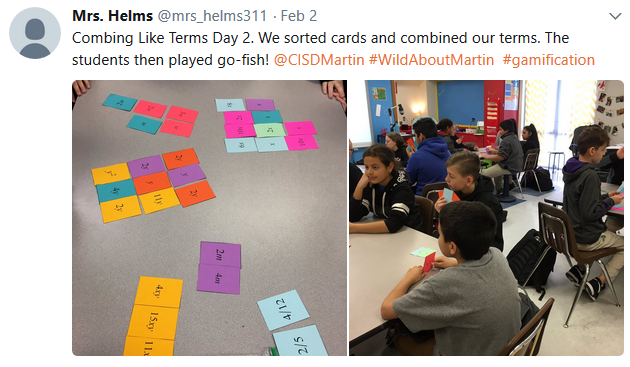
Algebra Quotes
Randy Miller shares some great quotes of how people use algebra in their day-to-day lives. I’d love to do something similar and collect quotes from people in our community!
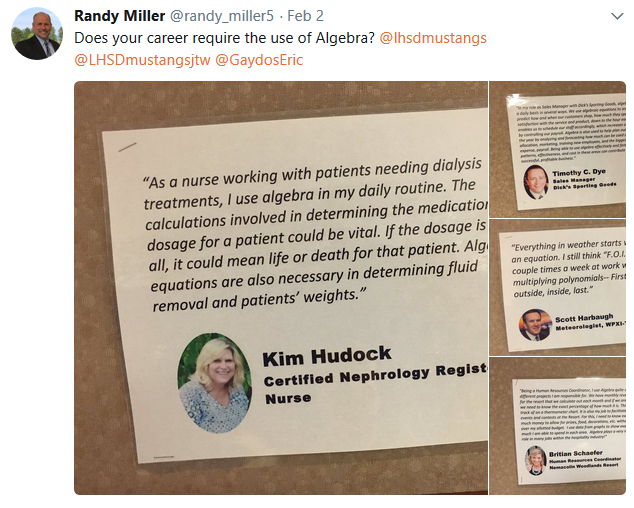
Valentine’s Day Projects
Clarissa Grandi shares some great Valentine’s day projects to bring a little more creative, artsy math into your classroom! Check out Clarissa’s beautiful, inspiring blog here.
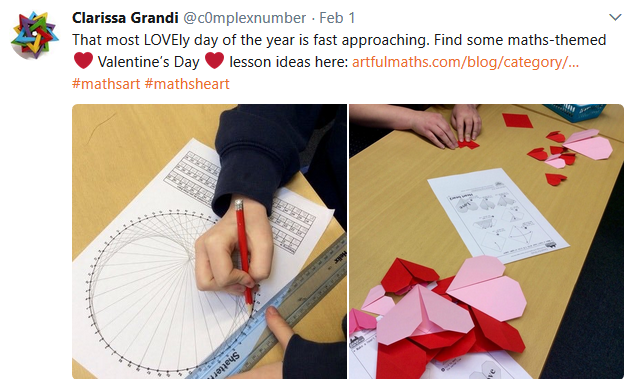
Systems of Equations Card Sort
Tony M shared a great card sort activity from ATM Mathematics, and it has got me thinking about how I want to approach our upcoming unit on systems of equations. Instead of just giving students a system of equations to solve, I can give them cards with pieces of information that can be COMBINED to allow them to solve the problems.
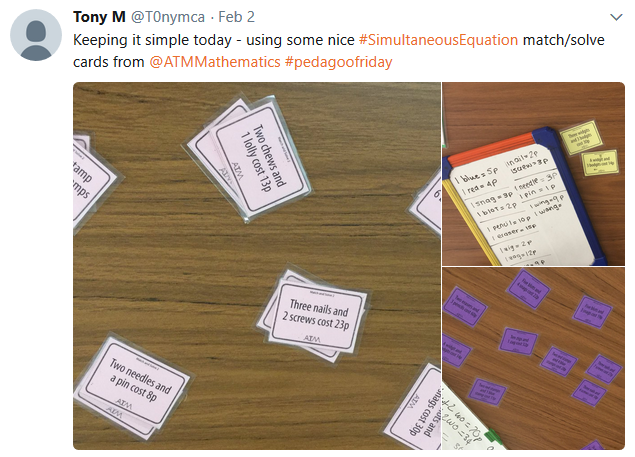
Student Reflection
I’ve been on the lookout lately for ways to make students more responsible for their own learning. I was very excited to come across this idea from Mrs PB. I need to find ways to have students reflect on their own work BEFORE they turn it in. I see potential for using this in math class!
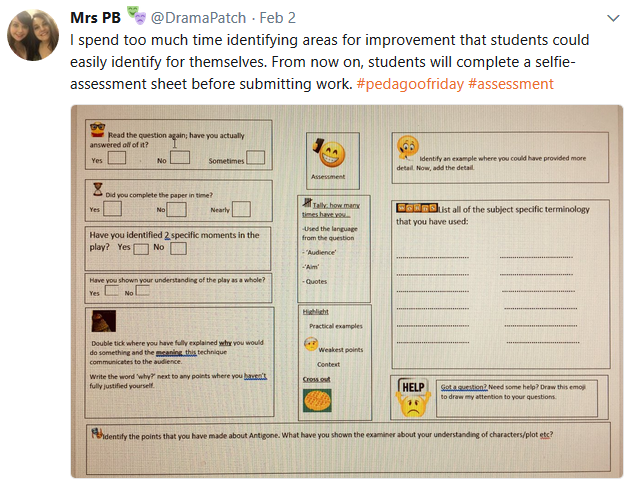
Parallel and Perpendicular Color Coding Activity
Elissa Miller shares a great color-sorting task for parallel and perpendicular lines. I especially like the fact that different representations of lines are used instead of solely using equations like I’ve done in the past.

Areas of Circles and Sectors Hands-On Activity
I love seeing the great, hands-on activities that Shaun Carter comes up with for his geometry classes. This area of a circle task is no exception. Check out Shaun’s blog to find more details and free printables here.
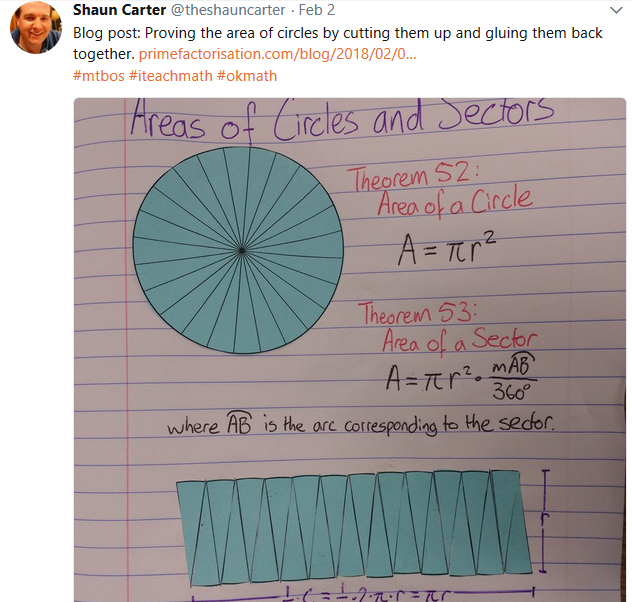
Color Coding Polynomials
Shaun Carter further inspires with a great example of color with a purpose in regards to analyzing the graphs of polynomials. You can find this file on Shaun’s blog here.
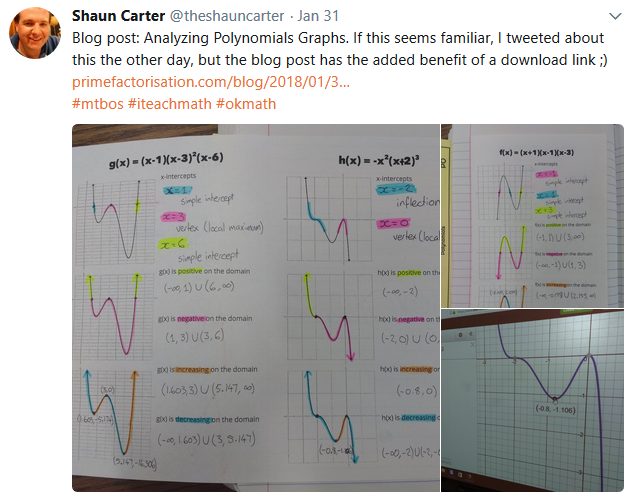
Kisses and Confidence Intervals
I am definitely a chocolate lover. So, when I saw that S. Leigh Nataro combined chocolate kisses with confidence intervals, I knew I had to file this idea away for the next time I teach stats! Check out her blog post here.
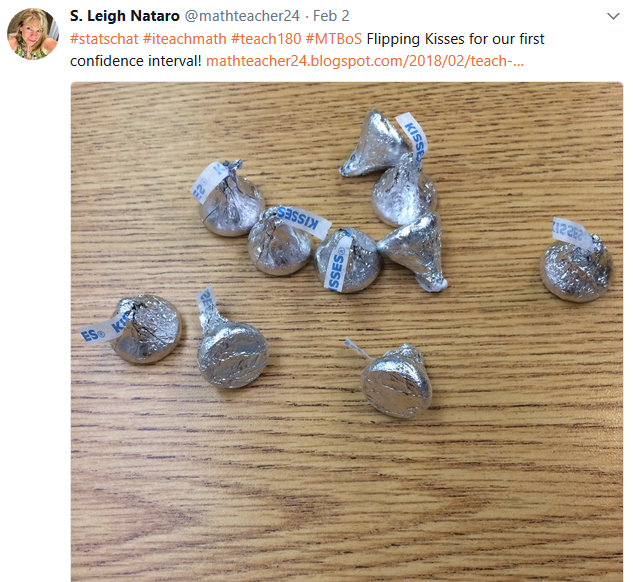
Fractal Wall Art
I love this beautiful fractal display from Kate Mitchell.
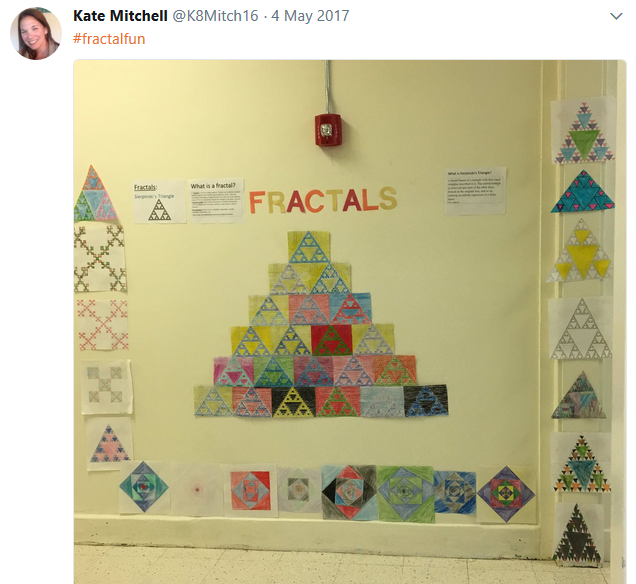
3D Printing Trophies
What cooler way to celebrate the winner of a roller coaster design challenge than 3D printed trophies?!? What a great idea from Steve Maier!

WODB with Pattern Blocks
I love using WODB (Which one doesn’t belong?) in my classroom. Miss Arndt combined cookie sheets, pattern blocks, and tape to give students a chance to create their own!
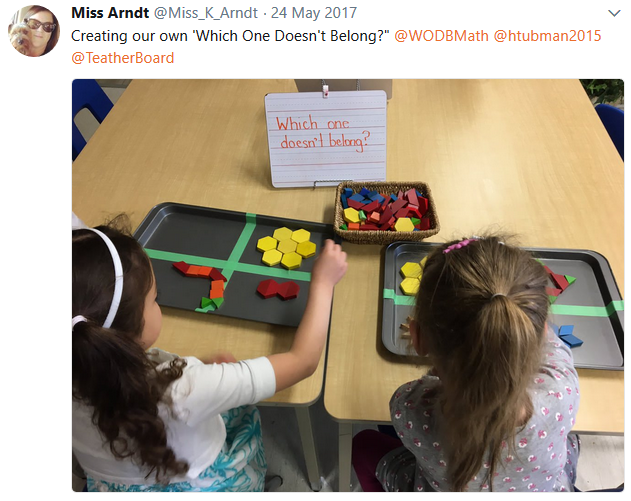
Sierpinski Triangle Counting Task
How would your students fare if you posed the same question to your class as Mr. Dyck?

Time to Solve the Tower of Hanoi Puzzle
I’m sure most of you are already familiar with the Tower of Hanoi puzzle. But, have you ever thought of it in terms of the time required to solve the puzzle? Thanks to TeatherBoard for sharing this photo which has got my mind working up some ideas for using this in my classroom!

Distributive Property with Dice in Dice
Gina Ging shares a brilliant idea for using dice in dice to make an engaging distributive property activity. I love how the inner die determines the sign of the number displayed on the outer die.
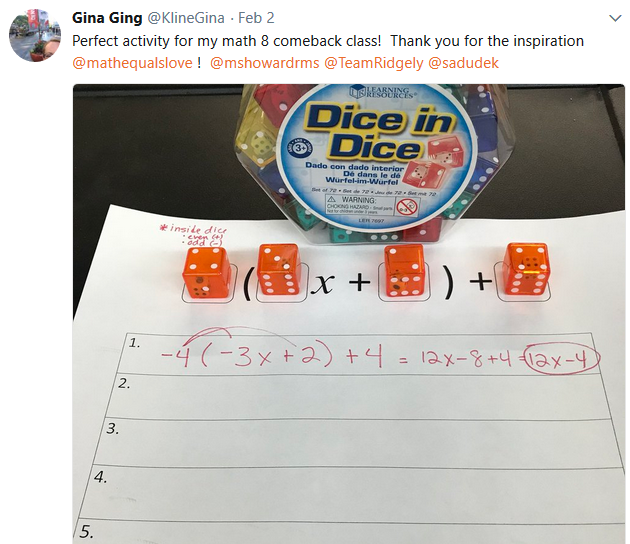
What were the Questions?
Julie Morgan has got my mind working overtime with ideas of how to adapt this question structure for my Algebra 1 classes.
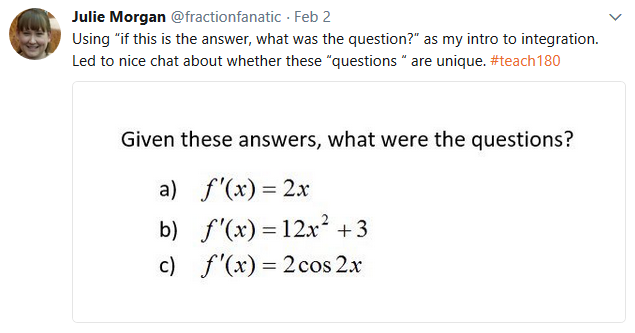
Tracing Puzzles
I was excited to run across some great puzzles on twitter from Gareth Ffowc Roberts. How many of these diagrams can you trace without ever raising your pencil or going over the same line twice?
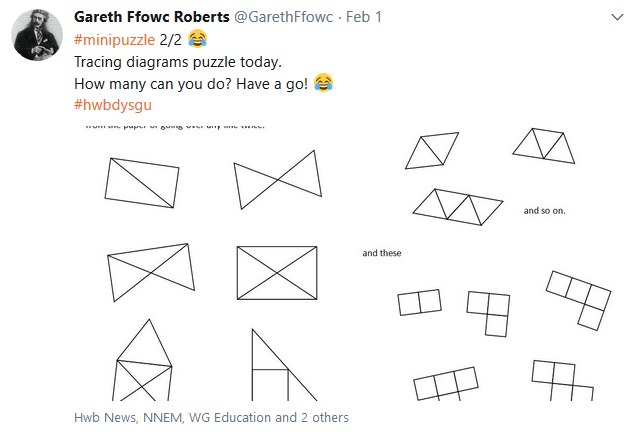
Forgotten Polynomials
Paul Jorgens‘ Forgotten Polynomial task will definitely be making an appearance in my polynomials unit!
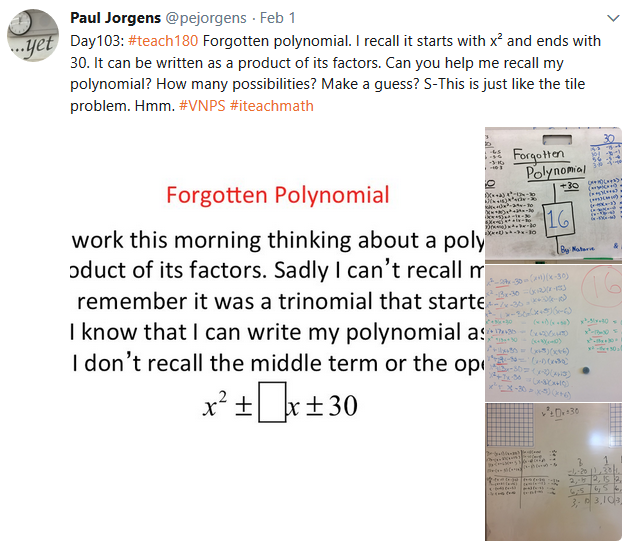
Algebra Tile Polynomial Puzzles
Here’s another great polynomial task from Paul Jorgens.

Fastest Fingers Calculator Task
My favorite activity shared by Paul this week, though, is this “Fastest Fingers” task to motivate the zero product property. This is pure brilliance.

Demonstrating Inverses with Patty Paper
If you aren’t using patty paper in your classroom, you are missing out. Amber Longhi shares an idea for using patty paper to demonstrate functions and their inverses.
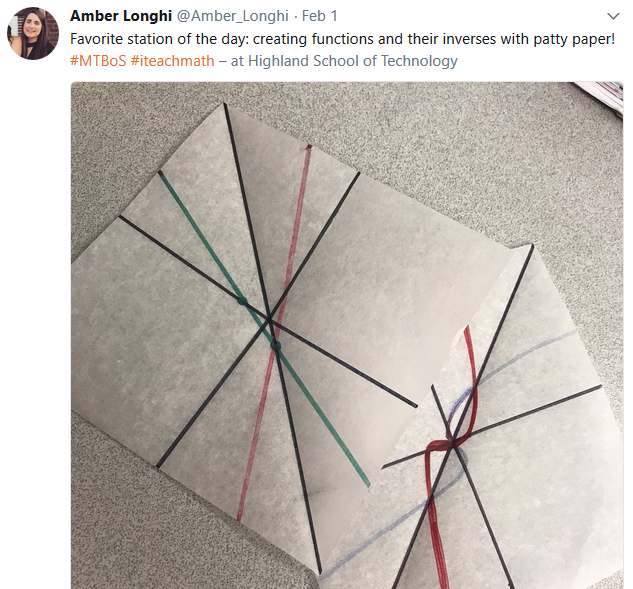
Function Auction Money
Madi Roberts took my Function Auction lesson to the next level by putting her own face on the money!
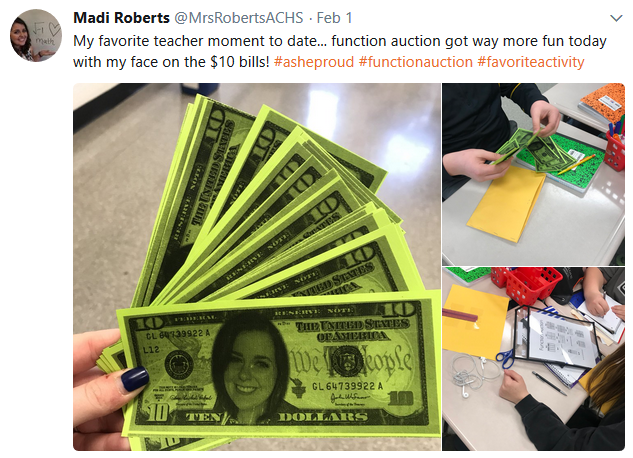
Super Bowl WODB
Want to incorporate the Super Bowl into your class? Check out this WODB (Which One Doesn’t Belong?) activity from Parmenter Math.

Image Source: https://twitter.com/ParmenterMath/status/959045943017529344
Composite Area Puzzle
Louis Lantiere combines a composite area problem with an open middle problem, and the result is awesome!
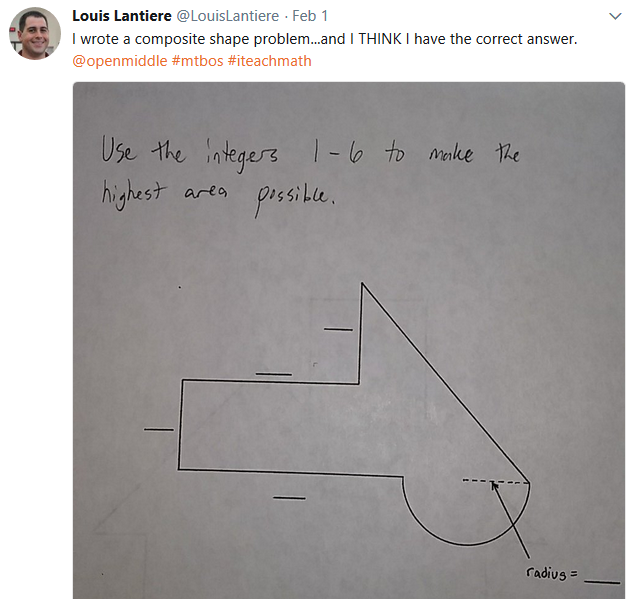
One Quarter Fraction Challenge
Mr. Brad Evans shares a fun, fraction challenge: how many different ways can you show 1/4?
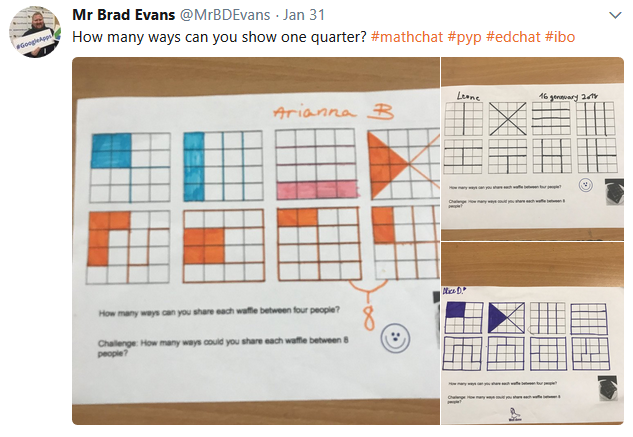
The Power of One Bulletin Board
Lisa Eischens inspires with some amazing mathematical bulletin boards!
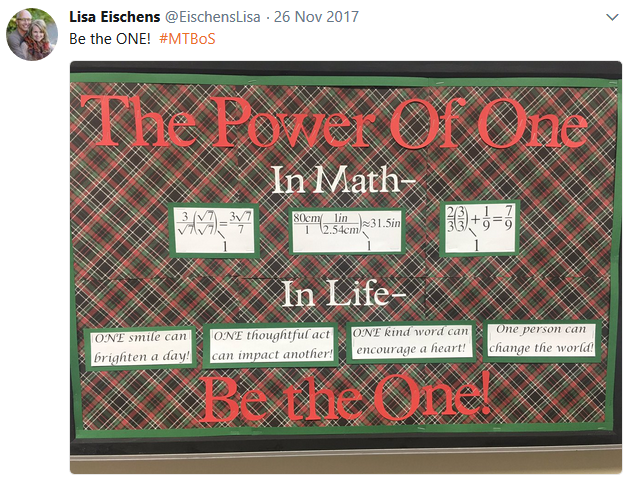
Imaginary Number Valentine’s Day Bulletin Board
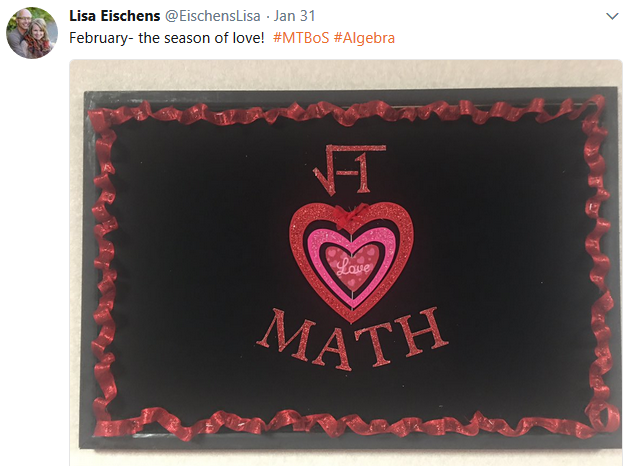
Mean Value Theorem Popcorn Lesson
I’ve never taught calculus, but this visual from Nicole Lalanne is brilliant. I’ll never think about the Mean Value Theorem the same way every again!
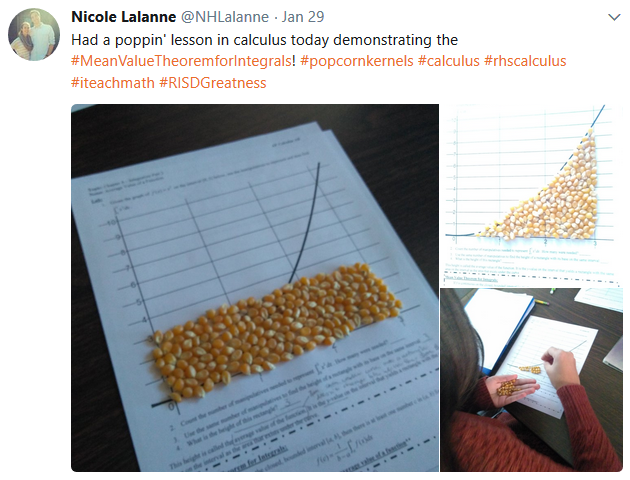
Classroom Tombstone
Jenise Sexton has convinced me that I need a tombstone in my classroom. Check out Jenise’s post here for more details.
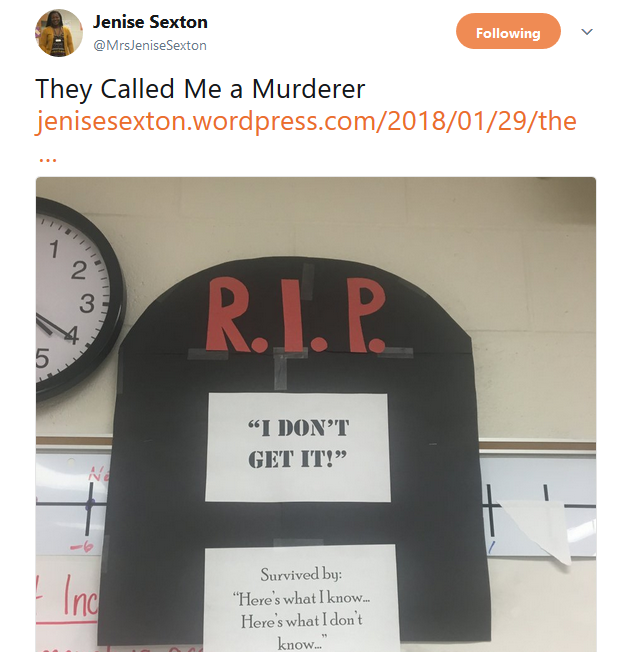
Alternatives to “I Don’t Know…”
Coach Fred is also fighting against “I don’t know.”
Partner Test
Charlotte Anne shares an assessment idea that has me intrigued. 2/3 of their test grade is determined by a traditional test. The other 1/3 is determined by a hands-on activity that is completed with a partner.

Visualizing the Size of an Atom
I’ve been working hard to get my chemistry students to wrap their minds around just how tiny an atom is and how tiny the nucleus is in regards to the entire atom. I love this visual from Andy. Now, I just need to modify it to center over Oklahoma to give my students a better idea of how big it is!

Golden Ratio Projects
I’m fully convinced that Jennifer Abel gives her geometry students the most interesting projects. Check out these golden ratio projects.

Integral Drawing Competition
Elyssa Stoddard knows how to inject some healthy competition into math class by having an integral drawing competition. I can SO see myself doing this with squiggly brackets in Algebra 1!

Personalizing Word Problems
Julia Anker shares a tiny lesson tweak that could make all the difference with your students.
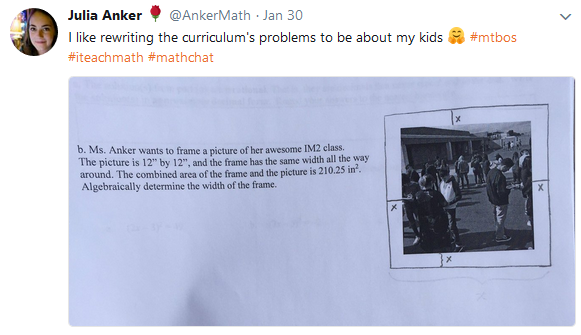
Binary Flippy Do
I’ve always struggled to understand how to write numbers in other bases. I think seeing something like this “Flippy Do” from WSD STEAM Students to explain binary would help me understand binary!
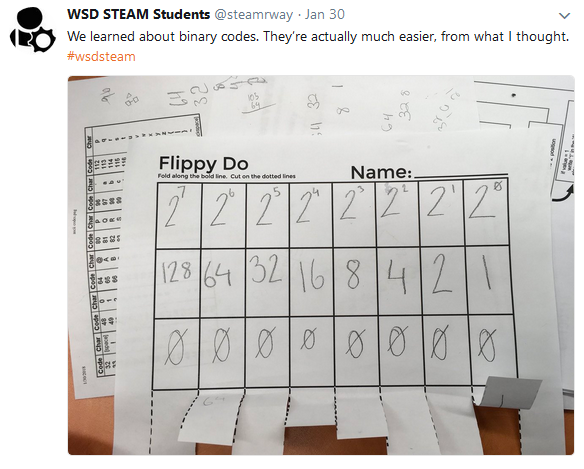
Shattered Window Task
Mr Etheridge shares an awesome task to use when studying area.
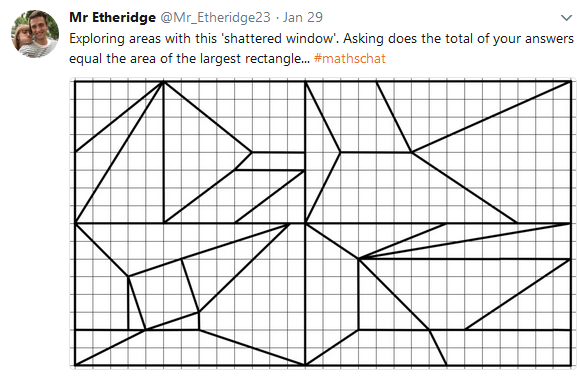
Adding Radicals Magic Square
Do your students need practice adding/subtracting radicals (surds)? Check out this magic square task from Mr Knowles.

Coordinates Task
Marcus Wong shares a great task involving analyzing coordinates. This could be easily adapted to focusing on graphing in all four quadrants.

What is the Same? What is Different?
Mrs. Donavan offers an example of a structure that can be applied to so many different math topics. What is the SAME? What is DIFFERENT?
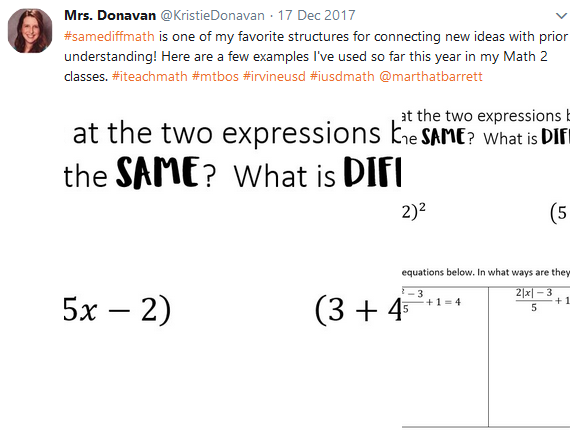
Super Bowl Data Tasks
I realize the Super Bowl will be over by the time you read this, but I can’t leave out this awesome Super Bowl themed task from Leslie Lewis.
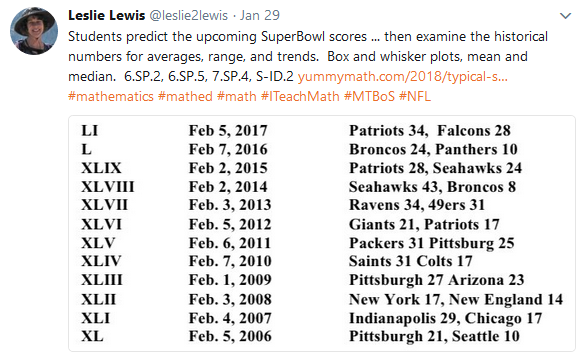
Factoring Monomials Activities
Lisa Richardson has shared some awesome factoring activities on her blog that you must check out!
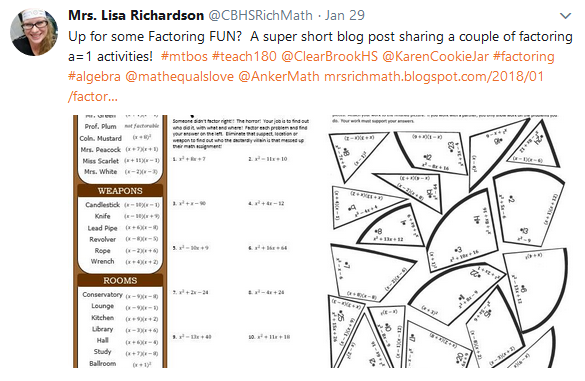
Sticky Note Strategy
Jade White shares a great idea for using sticky notes to allow students to correct their mistakes without erasing their previous work. Brilliant!
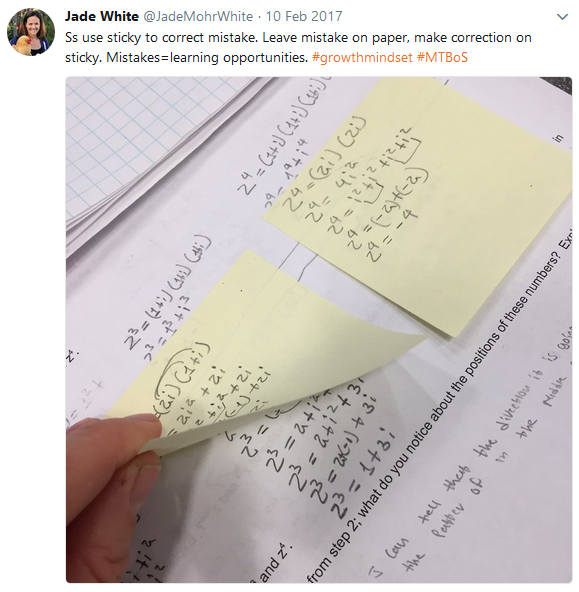
Capital F Puzzle
Benjamin Dickman shares an awesome puzzle that will definitely be making an appearance on my puzzle table!
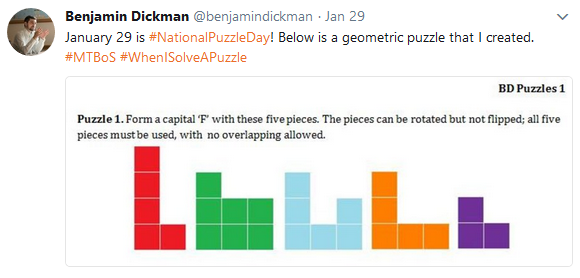
Until next week, keep sharing!

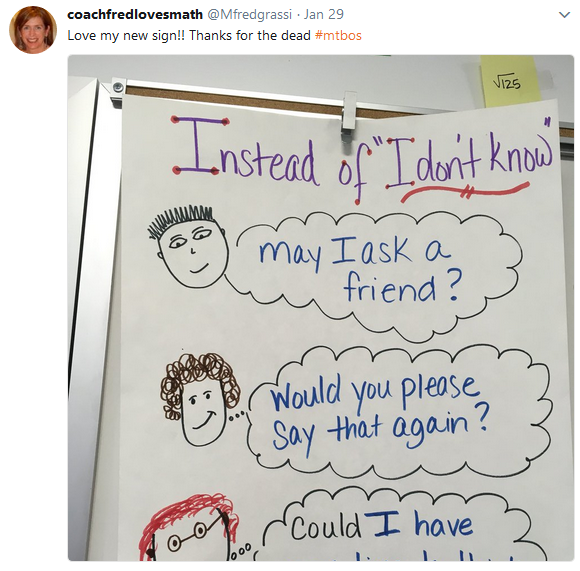

Quite a collection!
I particularly like Louis Lantiere's area task, though it's perhaps a bit too complex for me: with a slightly simpler task it might be easier to avoid trial and error.